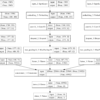A standard deep learning model for text classification and sentiment analysis uses a word embedding layer and one-dimensional convolutional neural network. The model can be expanded by using multiple parallel convolutional neural networks that read the source document using different kernel sizes. This, in effect, creates a multichannel convolutional neural network for text that reads […]










